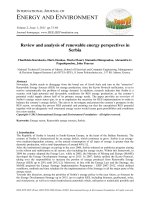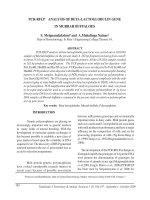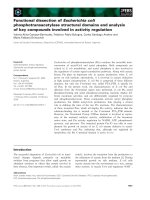Review and analysis of renewable energy perspectives in Serbia
Bạn đang xem bản rút gọn của tài liệu. Xem và tải ngay bản đầy đủ của tài liệu tại đây (183.78 KB, 14 trang )
I
NTERNATIONAL
J
OURNAL OF
E
NERGY AND
E
NVIRONMENT
Volume 2, Issue 1, 2011 pp.71-84
Journal homepage: www.IJEE.IEEFoundation.org
ISSN 2076-2895 (Print), ISSN 2076-2909 (Online) ©2011 International Energy & Environment Foundation. All rights reserved.
Review and analysis of renewable energy perspectives in
Serbia
Charikleia Karakosta, Haris Doukas, Maria Flouri, Stamatia Dimopoulou, Alexandra G.
Papadopoulou, John Psarras
National Technical University of Athens, School of Electrical and Computer Engineering, Management
& Decision Support Systems Lab (NTUA-EPU), 9, Iroon Polytechniou str., 157 80, Athens, Greece.
Abstract
Nowadays, Serbia needs to disengage from the broad use of fossil fuels and turn to the “attractive”
Renewable Energy Sources (RES) for energy production, since the Kyoto Protocol ratification, so as to
resolve systematically the problem of energy demand. In addition, research indicates that Serbia is a
country with high potential and favourable conditions for RES energy production, as the country’s
potential could supply almost half of its primary energy needs. The paper provides an overview of
Serbia’s energy sector status quo, so as to emphasize the necessity for RES implementation in order to
balance the country’s energy deficit. The aim is to investigate and present the country’s prospects in the
RES sector, revealing the proven RES potential and pointing out that the unexploited RES potential
together with an adequately well structured energy sector would create great possibilities and conditions
for a new market.
Copyright © 2011 International Energy and Environment Foundation - All rights reserved.
Keywords: Energy sector, Renewable energy sources, Serbia.
1. Introduction
The Republic of Serbia is located in South-Eastern Europe, in the heart of the Balkan Peninsula. The
country of Serbia is characterized by an energy deficit, which continues to grow. Serbia is an energy-
wise medium-dependent country, as the annual consumption of all types of energy is greater than the
domestic production, with a total dependence of around 40% [1].
After the institutional changes occurring in the year 2000, Serbia initiated an ambitious program aiming
in the reform and stabilization in all sectors, also including the energy sector. Within this framework, in
2004 the country adopted the Energy Law, while in 2005, the Ministry of Mining and Energy (MoME)
developed the Energy Development Strategy up to 2015. In 2007, Serbia ratified the Kyoto Protocol,
taking over the responsibility to increase the portion of energy produced from Renewable Energy
Sources (RES) up to 20% until 2012 [2]. Moreover, in line with the Energy Law and the Strategy, the
MoME prepared the Energy Strategy Implementation Programme - ESIP 2007–2012, which defined
conditions, methods and time schedule for the implementation of the Strategy in all the major parts of the
energy sector.
Towards this direction, among the priorities of Serbia’s energy policy in the near future, as foreseen by
the Energy Development Strategy up to 2015, are to exploit RES, including biomass, geothermal, solar,
and wind power, as well as to retain hydroelectric potentials which, utilization is technically possible and
International Journal of Energy and Environment (IJEE), Volume 2, Issue 1, 2011, pp.71-84
ISSN 2076-2895 (Print), ISSN 2076-2909 (Online) ©2011 International Energy & Environment Foundation. All rights reserved.
72
economically feasible, especially on smaller rivers [3]. Furthermore, the Strategy targets the increase of
RES share in the total energy production from 1,5% (2006) to 4,5% (2010), the increase of RES share in
total energy consumption to 1,5-2% by 2015 and a 20% decrease of the specific energy consumption by
2020, while it includes directives for biofuels, which are in line with EU Directives [4, 5].
Currently, as officially registered in the Serbian Energy Balance, the only RES utilized for electricity
generation is hydropower [6], while non-commercial use of biomass and geothermal energy also occurs
[7]. On the other hand, researches point out that Serbia will be capable to respond adequately to Kyoto
Protocol demands and to the European rules, regarding the substitution of certain amounts of fossil fuels
by RES [4], due to large potentials in all types of RES and especially from geothermal sources, wind and
biomass [2].
Regarding all these factors, scope of this research is to investigate the RES potential existing in the
country of Serbia in order to identify the most promising ones for their implementation and integration in
the country’s energy mix, towards the achievement of the RES targets and the country’s disengagement
from fossil fuels.
Apart from the introduction, this paper is structured along three sections. Section 2 presents a description
of Serbia’s energy sector, its electricity and heat transmission and distribution characteristics and its
energy production and consumption features. Section 3 provides a detailed analysis of the RES potential
in Serbia, while Section 4 summarizes the main results drawn up from this paper.
2. Energy sector current situation
In Serbia there is one main energy state-owned company, the Electric Power Utility of Serbia (EPS),
which encompasses coal mines, electric power sources (hydroelectric power plants, thermal power
plants, heating plants) and grid distribution systems. The Oil & Gas Company (Naftna industrija Srbije -
NIS) that controls the production, refining and distribution of crude oil and oil derivatives, was a state-
owned company up until 2005, but during that year the Serbian Government started its privatisation
process and in 2006 the government accepted NIS’s privatization strategy. Moreover, the Public
Enterprise for electric energy transmission and transmission system, which was established in July 2005,
controls “Elektromreža Srbije - EMS”, the Serbian Transmission System and the Market Operator. As it
can be observed, no private companies, involved in generation (only few small private producers for their
own purposes), transmission and distribution of energy exist [8].
2.1 Electricity transmission and distribution
The electric power transmission system of Serbia consists of a high voltage system amounting to 400 kV,
220 kV, and 110 kV (part of the system) as well as the other power plants, telecommunication system,
information system and other infrastructure facilities necessary for the power system’s operation. The
total length of the transmission lines (excluding Kosovo) is 8.864 km. In the last 5-6 years the efficiency
of the transmission network has significantly improved. Transmission system losses have decreased from
values around 4% in 1998-99 to 2.8% in 2007, as the amount of delivered energy continuously increases.
EMS has six regional transmission units, namely Belgrade, Bor, Valjevo, Krusevac, Novi Sad and Oblic.
The electricity supplied to the distribution subsidiaries and the structure of electricity sales for 2009 is
presented in Tables 1 and 2 correspondingly.
Table 1. Electricity Available in 2009
Distribution Company GWh %
Elektrovojvodna ltD, Novi Sad 8.799 27,48
Elektrodistribucija ltD, Beograd 7.963 24,87
Elektrosrbija ltD, Kraljevo 7.387 23,07
Jugoistok ltD, Nis 4.889 15,26
Centar ltD, Kragujevac 2.985 9,32
Total 32.023 100
Source: [9]
International Journal of Energy and Environment (IJEE), Volume 2, Issue 1, 2011, pp.71-84
ISSN 2076-2895 (Print), ISSN 2076-2909 (Online) ©2011 International Energy & Environment Foundation. All rights reserved.
73
Table 2. Electricity supplied in 2009
Electricity Supplied
Voltage Level/
Category of Consumption
GWh %
Number of Buyers/
Measuring Points
High Voltage – 110kV 2.052 7,56 32
Middle Voltage – 35kV 729 2,69 158
Middle Voltage – 10(20)kV 4.397 16,19 3.946
Low Voltage (0,4kV I Level) 3.144 11,58 45.956
Consumer Spending (0,4kV II Level) 1.944 7,16 302.095
Consumer Spending - Households 14.412 53,07 3.092.470
Public Lighting 479 1,76 23.736
Total 27.158 100 3.468.393
Source: [9]
2.2 District heating
District heating (DH) systems are an important part of the country’s energy sector. There are a total of 45
cities and towns that have DH, provided by about 55 DH companies. DH companies are in the
jurisdiction of local government, resulting in a great diversity of conditions, in regard to the companies’
operating efficiencies, quality of services provided, financial conditions, etc. Most district heating
systems are characterized by low efficiency and by generation and distribution losses that exceed 20 % of
generation. The transmission system losses during 2008-2009 are presented in Table 3. The main
characteristics of Serbia’s heating plants are low operating readiness due to insufficient maintenance and
outdated equipment, financial exhaustion and an inability to perform urgent intervention on sources and
grids. There is a need for additional capacity. As a considerable part of the population uses electricity for
heating, it is a strategic consideration to connect more consumers to the DH network, in order to alleviate
the burden on the electricity grid. Additional capacity for this goal is expected to be achieved through
DH revitalization and modernisation.
Table 3. Transmission system losses during 2008-2009
Month GWh % Month GWh %
Jan 08 133.305 2,94 Oct 08 92.456 2,58
Feb 08 114.293 2,83 Nov 08 100.172 2,58
Mar 08 116.628 2,84 Dec 08 121.854 2,88
Apr 08 99.660 2,87 Jan 09 120.691 2,78
May 08 89.841 2,76 Feb 09 106.302 2,85
June 08 82.905 2,75 Mar 09 106.501 2,73
July 08 98.213 2,97 Apr 09 73.115 2,55
Aug 08 94.590 2,89 May 09 71.169 2,54
Sep 08 80.062 2,54
Source: [10]
2.3 Energy production and consumption
Serbia has a diverse energy supply sector, composed of coal extraction, oil and gas production, imports
of crude oil, oil products and gas, coal and hydro electricity generation, district heating systems and
industrial energy systems.
International Journal of Energy and Environment (IJEE), Volume 2, Issue 1, 2011, pp.71-84
ISSN 2076-2895 (Print), ISSN 2076-2909 (Online) ©2011 International Energy & Environment Foundation. All rights reserved.
74
Total Primary Energy Supply (TPES) in Serbia reached 17.6 Mtoe in 2008 [11], a 7.5% rise from the
previous year. Serbia imports about 40% of its energy needs, mainly in the form of crude oil, gas and
petroleum products. Energy intensity is 0.33 ktoe/US$(2000) the highest among all Energy Treaty
parties, indicating that energy is not produced and/or used efficiently.
As presented in Table 4 the power generation installed capacity was 8.359 MW in 2008 (including
Kosovo A and B plants), of which 5.171 MW correspond to coal-fired TPPs; 353 MW to CHP plants
(dual gas-mazut fired); and 2.831 MW to HPPs. It must be mentioned that, since 1991, Serbia is not
operating the two TPPs located in Kosovo (Kosovo A and B). Without these plants, the total installed
capacity is 7124 MW. Due to lack of regular maintenance in the period 1990-2000, TPPs’ availability
was low and threatened the power system operational security. However, reliability of Serbian TPPs
improved significantly since 2000. Forced slowdowns were reduced from 19.5% in 2000 to 5.3% in
2008.
The total electricity production in 2008 reached about 40 TWh, of which 30 TWh were produced by
TPPs (including CHP) and the remaining 10 TWh by HPPs.
Table 4. Installed capacity of power generation facilities in 2005 and 2008
Net Output Capacity (MW) Power Plant
2005 2008
TPP Nikola Tesla A 1.502 1.502
TPP Nikola Tesla B 1.160 1.160
TPP Kolubara 245 245
TPP Morava 108 108
TPP Kostolac A 281 281
TPP Kostolac B 640 640
TPP Kosovo A 617 617
TPP Kosovo B 618 618
Thermal Power Plants 5.171 5.171
TPP-HP Novi Sad 208 208
TPP-HP Zrenjanin 100 100
TPP-HP Sremska Mitrovica 45 45
Thermal Power Plants – Heating Plants 353 353
HPP Djerdap I 1.058 1.058
HPP Djerdap II 270 270
HPP Vlasina 129 129
HPP Pirot 80 80
HPP Bajina Basta 364 364
PUMPED-STORAGE PP Bajina Basta 614 614
HPP Zvornik 92 96
HPP Elektromorava 13 13
HPP Limske 211 211
Hydro-Power Plants 2.831 2.835
Power Plants Owned by EPS 8.355 8.359
HPP Piva 342 342
HPP Gazivode 35 35
Other Power Plants 377 377
Total 8.732 8.736
Source: [6, 12]
International Journal of Energy and Environment (IJEE), Volume 2, Issue 1, 2011, pp.71-84
ISSN 2076-2895 (Print), ISSN 2076-2909 (Online) ©2011 International Energy & Environment Foundation. All rights reserved.
75
Serbia has a small oil production capacity, which covers about 17% of total oil supply. The country has
two refineries with total installed processing capacity of 7.8 million tons a year (4.8 million tons in
Pančevo and 3 million tons in Novi Sad). Since 2007, the oil refineries are operating at 84 % capacity
only (at 6.6 million tons total: 4.8 million tons in Pančevo and 1.8 million tons in Novi Sad). The length
of the oil pipeline network within Serbia is 177 km [12]. The current capacity of the refineries is not
sufficient to cover local demand, therefore Serbia imports oil products. Finally, there is also a small gas
production, which covers about 10% of total gas demand. The rest is imported from Russia by Srbijagas,
a company for trading in and processing natural gas. The total annual consumption of natural gas in 2006
was 2.349 mil m
3
.
Regarding the energy consumption, Serbia consumed 15 Mtoe of energy in 2007. The structure of the
TPES was as follows: 52% coal (mostly local lignite), 27% oil, 12% natural gas, and 7% hydro [4]. The
Final Energy Consumption (FEC) was 10 Mtoe, of which 35% was accounted by industry, 32% by the
residential sector and 18% by the transport sector.
In 2007, the total amount of electricity delivered to consumers in Serbia was 28.749 GWh, while the
household sector had the greatest share in consumption (52,5%). In 2007 the average selling price of
electricity for EPS consumers was 3.699 RSD/kWh or 4,62 €c/kWh, calculated at the average exchange
rate of RSD 80,09 for 1€ in 2007. [13, 14]
Changes in the volume and structure of energy consumption per sector reflect the overall tendencies in
Serbian economy, as presented in Table 5. Total consumption is still below the 1990 level.
Table 5. Energy consumption per sector (Mtoe)
Industry Transport Households & Other Year
Total % Total % Total %
Total
Consumption
1990 3,92 43 1,82 20 3,29 36 9,03
2002 2,42 35 1,58 22 2,94 42 6,94
2005 2,25 30 1,98 27 3,17 43 7,40
2006 2,59 35 1,77 24 3,00 41 7,36
2008 2,67 35 1,92 25 3,02 40 7,62
Source: [14]
As one can observe, energy consumption has increased within the period 1990-2006, as the overall
economic activity and living standards of households raised [15, 16]. The household sector accounted for
43% of energy consumption in 2005, while industry, had a share of about 30% in 2005 [12]. In 2008, the
energy consumption seems to stabilize. The household sector accounted for almost 40% of the electricity
consumption, which overcame the industry sector that accounted for 35% of the electricity consumption
[17]. Finally, the final electricity and heat consumption, for the years 2004 -2006 and the electricity
generation structure and gross consumption for 2009 are presented in Table 6 and Figures 1 and 2
respectively.
Table 6. Final electricity and heat consumption
Year Final Electricity Consumption
(TWh)
Final Heat Consumption
(TJ)
2004 22,7 32.093
2005 25,6 44.854
2006 26,2 41.387
Source: [11, 18]









